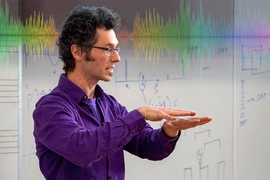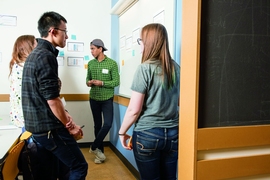Before computers, no sane person would have set out to count gender pronouns in 4,000 novels, but the results can be revealing, as MIT’s new digital humanities program recently discovered.
Launched with a $1.3 million grant from the Andrew W. Mellon Foundation, the Program in Digital Humanities brings computation together with humanities research, with the goal of building a community “fluent in both languages,” says Michael Scott Cuthbert, associate professor of music, Music21 inventor, and director of digital humanities at MIT.
“In the past, it has been somewhat rare, and extremely rare beyond MIT, for humanists to be fully equipped to frame questions in ways that are easy to put in computer science terms, and equally rare for computer scientists to be deeply educated in humanities research. There has been a communications gap,” Cuthbert says. “That's the genesis of this new approach to computation in humanities.”
Educating bilinguals: students fluent in the humanities and computation
While traditional digital humanities programs attempt to provide humanities scholars with some computational skills, the situation at MIT is different: Most MIT students already have or are learning basic programming skills, and all MIT undergraduates also take some humanities classes. Cuthbert believes this difference will make MIT’s program a great success.
“What we have that's an amazing opportunity is a large number of people who love building things with computers and want to connect those to their interests and make an impact,” he says. “Our students very much want to change the world.”
They can do that — even as first-year students — because humanities research has many open questions that can be solved with just six months or a year of programming skills, he says.
“The wonderful thing we can do is implement a lot from scratch because we have the programming skills to do that,” says Stephan Risi, one of two postdocs who works in what the students informally call the “Digital Humanities Lab,” or “DH Lab” for short. This gives the MIT researchers more latitude to explore new questions as they arise. “We’re not bound by software others have produced.”
A novel research project
To illustrate the kind of work the lab can do, the program enlisted a team of 24 students (mostly first-years) through the MIT Undergraduate Research Opportunities Program (UROP) to study gender representation in 19th century English literature. The team assembled metadata, applied grammar-parsing tools, did web scraping, wrote analysis tools, and ultimately examined 4,217 books — a total of 326.9 million words.
One interesting finding from the "Gender/Novels" experiment was that — regardless of the sex of the author and "no matter how we cut the data,” as Cuthbert says — roughly two-thirds of all male pronouns were in the subject position, whereas women were more often the object of the sentence. What these new data tell us — about men, women, and society — is up to human scholars to decide, but this project provides a window into the ways computational work can support humanities research.
Detecting research with high social value
This first project also illustrates the pedagogical benefits of working in the lab.
“One of the interesting things about the lab is it's hard to sift through which ideas have merit,” says lab UROP and first-year student Dina Atia, contrasting the humanities research to her work in science, technology, engineering, and math (STEM) fields. “Most STEM research is very fact-based but can lack important social takeaways.”
Fellow UROP and first-year student Ifeoluwapo Ademolu-Odeneye says she enjoyed the opportunity to put her computer skills to work outside the classroom. “I have developed a lot as a computer scientist doing this,” she says, adding that she has also learned to apply critical thinking skills to make decisions about the humanities content. “At first, I asked Professor Cuthbert about everything. Later he threw questions back at us, which has been good for developing as a researcher myself.”
First-year student Mayowa Songonuga, who just started her UROP in the lab this spring and is working on a new project — The History of Computing at MIT — agreed that the hands-on work is very valuable. “There is more to it than just the technology,” she says. “I haven't had the chance to research something like this before.”
The productive swerve in research
While the UROP students were designing algorithms and building a website, they also read and analyzed 19th century English literature and tackled questions such as how to teach the computer the difference between a novel and a travel log. The lab intentionally fosters this dual-stream process, Cuthbert says, because it provides rich opportunities to change the direction of research to follow some newly discovered path.
This ability to make what Cuthbert calls “a productive swerve” is often critical to fruitful research, but has been hampered in the digital humanities to date because complex digital projects are too often done by computational experts at a remove from the humanities scholar.
Students collaborate with leading humanities scholars
To further entwine the disciplines, the program next plans to bring humanities faculty on board for joint projects with students. In 2019-20, associate professor of literature Sandy Alexandre and professor of political science Evan Lieberman will be devoting six hours a week to the lab, teaching students about their research while learning some computational methods themselves.
An added benefit of this collaboration is that it should make the programming work less demanding, Cuthbert says, because creating a simple user interface can be extremely time-consuming. “We’re hoping the faculty will learn enough about the technical operation of their projects that we can devote more staff time to digging deeper,” he says.
Master class lectures by experts who combine humanities and tech
Beginning in 2020, the Program in Digital Humanities will reach out to the wider community — at MIT and in Cambridge and Boston. The plan, Cuthbert says, is to develop a lecture series based on the master class model. Outside experts who combine technology and the humanities in their profession will come to the lab to work with students and then give a public lecture.
The overall goal, Cuthbert says, is to meet a target set by Melissa Nobles, the Kenan Sahin Dean School of Humanities, Arts, and Social Sciences: “to connect the great things going on in computation with the amazing things happening in MIT’s humanities, arts, and social science fields.”
“We have an opportunity to create a love for humanities and an acknowledgement of the importance of humanistic research with the next generation of computer programmers,” Cuthbert says. “We are incredibly excited.”











